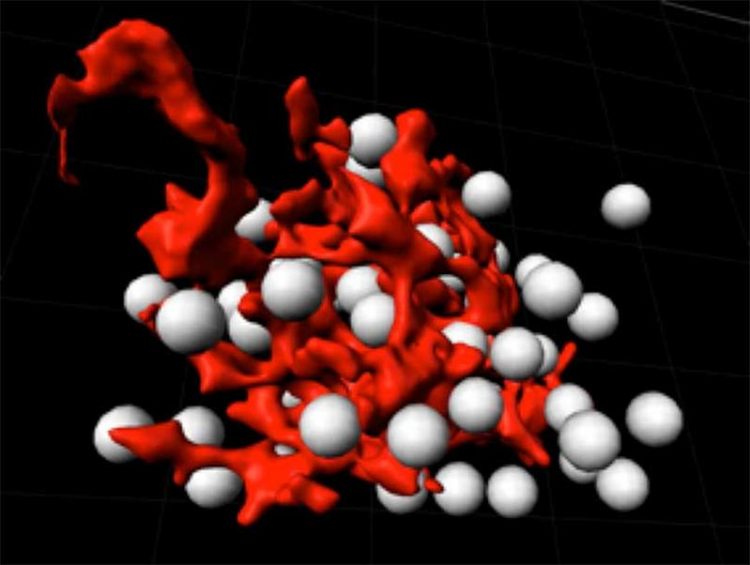Genetic Regulation of the Thymus Function Identified

A single thymic epithelial cell (red) in contact with developing T cells (white). Department of Biomedicine, University of Basel
Like all vertebrate animals, humans use T cells in immune defense in order to protect the body against infections and malignant cells. Immune cells mature in the thymus, an organ located between the sternum and heart, during the embryonic stage, but they reach full functionality only when they interact with thymus epithelial cells – the teachers of the T cell, so to speak. The thymus begins to age from the second year of life.
More than 20 years ago, researchers discovered that the protein Foxn1 plays an important role in the development and differentiation of thymic epithelial cells. But it remained unclear which target genes controlled by Foxn1 were responsible for the formation and functions of the specialized epithelial cells. It was also unclear what Foxn1 actually did after development of the thymus in the embryo.
Healthy adults do not directly depend on the work of the thymus; however, the organ’s function becomes important again once the body requires new T cells – for example, after chemotherapy or a bone marrow transplant. To prevent the patient from remaining highly immune-deficient, thymic epithelial cells have to instruct the generation of new T cells.
Genome map of the regulator Foxn1
Researchers at the University of Basel, the University Children’s Hospital Basel and the University of Oxford have now succeeded in identifying in thymic epithelial cells the DNA sequence bound by the protein. The team, led by Professor Georg A. Holländer, was able to create a genome-wide map that lists all the DNA segments regulated by Foxn1. It emerged that Foxn1 controls almost all functions of the thymus, in whole or in part. “The protein is not only involved in the development of the organ, it also remains essential for its function throughout a person's life,” says the immunologist.
The research results provide important insights into the regulatory functions of thymic epithelial cells and could contribute to the development of new strategies for maintaining the thymus function in old age. “Now that we know exactly what Foxn1 does, we can think about how we can keep the thymus functioning in old age to reduce the risk of autoimmune disease and increased susceptibility to infections and tumors,” says Holländer.
Original article
Saulius Žuklys, Adam Handel, Saule Zhanybekova, Fatima Govani, Marcel Keller, Stefano Maio, Carlos E. Mayer, Hong Ying Teh, Katrin Hafen, Giuseppe Gallone, Thomas Barthlott, Chris P. Ponting and Georg A. Holländer
Foxn1 regulates key target genes essential for T cell development in postnatal thymic epithelial cells
Nature Immunology (2016), doi: 10.1038/ni.3537
Further information
Georg A. Holländer, University of Basel, Department of Biomedicine/University Children’s Hospital Basel, Tel. +41 61 270 50 69, email: georg-a.hollaender@unibas.ch
Saulius Zuklys, University of Basel, Department of Biomedicine/University Children’s Hospital Basel, Tel. +41 61 207 50 68, email: saulius.zuklys@unibas.ch
https://www.unibas.ch/en/News-Events/News/Uni-Research/Genetic-Regulation-of-the…
Media Contact
All latest news from the category: Life Sciences and Chemistry
Articles and reports from the Life Sciences and chemistry area deal with applied and basic research into modern biology, chemistry and human medicine.
Valuable information can be found on a range of life sciences fields including bacteriology, biochemistry, bionics, bioinformatics, biophysics, biotechnology, genetics, geobotany, human biology, marine biology, microbiology, molecular biology, cellular biology, zoology, bioinorganic chemistry, microchemistry and environmental chemistry.
Newest articles

NASA: Mystery of life’s handedness deepens
The mystery of why life uses molecules with specific orientations has deepened with a NASA-funded discovery that RNA — a key molecule thought to have potentially held the instructions for…

What are the effects of historic lithium mining on water quality?
Study reveals low levels of common contaminants but high levels of other elements in waters associated with an abandoned lithium mine. Lithium ore and mining waste from a historic lithium…

Quantum-inspired design boosts efficiency of heat-to-electricity conversion
Rice engineers take unconventional route to improving thermophotovoltaic systems. Researchers at Rice University have found a new way to improve a key element of thermophotovoltaic (TPV) systems, which convert heat…



